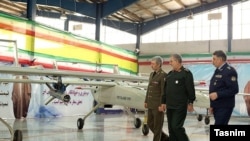Iran's Defense Minister on April 17 announced that a "massive number" of multirole, reconnaissance and combat UAVs, as well as Karrarr and Ababil-3 drones produced by the Aircraft Manufacturing Industrial Company (HESA), has been delivered to the Army's Air Force and Air Defense.
The announcement was made by Brigadier-General Amir Hatami at a ceremony on the occasion of the Army Day (April 17) who said these UAVs have been designed for intelligence, surveillance, and reconnaissance use.
According to Brigadier-General Hatami the drones delivered to the Army's Air Force and Air Defense units include multirole UAVs, Karrar (also spelled as Karar "Strike") jet-powered target drones, and Ababil 3 (also known as Ababeel "Swallow") surveillance and reconnaissance drones.
The delivered drones will cover an important section of Air Defense and Air Force operations and can be used as target planes as well as for deception on the enemy’s air defense networks, he said.
Describing the multirole drones, Brigadier-General Hatami said the 470 kg drones, have a speed of 900 km/h and a range of 1000 km, and can be deployed for a duration of 180 minutes without interruption at an altitude of 40,000 – 45,000 feet.
Ababil-3 drones are mid-range combat drones with the capability of carrying various electro-optic and combat equipment, the Iranian Defense Minister said and added that the drones are mainly used for gathering and transmitting optical data and can also be deployed for combat operations with an operation range of 150 km.
According to Brigadier-General Hatami jet-powered Karrar drones have the capability of carrying and dropping loads and have been upgraded to add combat and self-destruction capabilities.
In August 2019 Iran unveiled three domestically-produced "precision-guided smart bombs" -- Yasin, Balaban and a new series of Qaem) – which the Defense Minister said could be installed on various kinds of drones.
In October 2019 Western powers and Saudi Arabia said Iran was behind the attack on Saudi oil installations with drones and cruise missiles.





